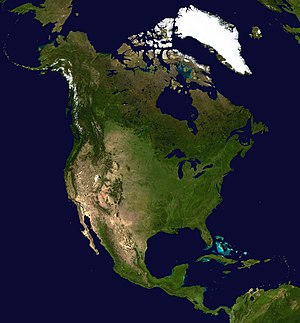
Back تاريخ أمريكا الشمالية Arabic Historia d'América del Norte AST Төньяҡ Америка тарихы BA উত্তর আমেরিকার ইতিহাস Bengali/Bangla Història d'Amèrica del Nord Catalan Hanes Gogledd America CY Geschichte Nordamerikas German Historia de América del Norte Spanish Ipar Amerikako historia EU تاریخ آمریکای شمالی FA
This article possibly contains original research. (May 2019) |


The History of North America encompasses the past developments of people populating the continent of North America. While it was commonly accepted that the continent first became inhabited by humans when individuals migrated across the Bering Sea 40,000 to 17,000 years ago,[1] more recent discoveries may have pushed those estimates back at least another 90,000 years.[2] People settled throughout the continent and, over time, developed into diverse communities, from the Inuit in the far north to the Mayans and Aztecs in the south. These complex communities each developed their own unique cultures and ways of life.
Records of European travel to North America begin with the Norse colonization in the 10th century AD. In 985, they founded a settlement on Greenland that persisted until the early 1400s. They also explored the east coast of Canada, but their settlements there were much smaller and shorter-lived. With the Age of Exploration and the voyages of Christopher Columbus (starting in 1492), Europeans began to arrive in the Americas in large numbers and develop colonial ambitions for both North and South America.[citation needed] An influx of Europeans soon followed Columbus and overwhelmed native populations as North America became a staging ground for ongoing European rivalries. The continent was divided by three prominent European powers: England, France, and Spain. The influence of colonization by these states on North American cultures is still apparent today.
Conflict over resources in North America ensued in various wars between these powers, but the new European colonies gradually developed desires for independence. Revolutions, such as the American Revolution and the Mexican War of Independence, created new, independent states that came to dominate North America. The Canadian Confederation formed in 1867, marking the beginning of the modern political landscape of North America.
North American states have, since the 19th century, developed increasingly deep connections with each other. Although some conflicts have occurred, the continent has enjoyed general peace and cooperation, as well as open commerce and trade, between its states. Modern developments include the opening of free trade agreements in 1994[3] and heightened emigration rates and drug trafficking concerns in Mexico and Latin America.
- ^ "Atlas of the Human Journey – The Genographic Project". National Geographic Society. 1996–2008. Archived from the original on May 1, 2011. Retrieved October 6, 2009.
- ^ Holen, Kathleen A.; Vescera, Lawrence; Rountrey, Adam N.; Cerutti, Richard A.; Beeton, Jared M.; Jefferson, George T.; Paces, James B.; Fullagar, Richard; Fisher, Daniel C. (April 2017). "A 130,000-year-old archaeological site in southern California, USA". Nature. 544 (7651): 479–483. Bibcode:2017Natur.544..479H. doi:10.1038/nature22065. ISSN 1476-4687. PMID 28447646.
- ^ "North American Free Trade Agreement". U.S. Customs and Border Protection. June 28, 2023. Retrieved April 4, 2024.